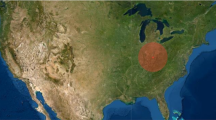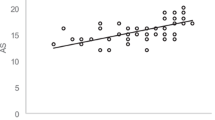Abstract
Adults were taken to various positions on a college campus and asked to mark their locations on a round or square map drawn from either directly overhead or from an oblique angle. In session 1, participants were also given paper and pencil spatial tests to assess their skills in mental rotation (2D figure rotation), spatial visualization (paper folding), and spatial perception (water level). In session 2, participants completed computer-based navigation and mapping tasks. Performance varied widely among participants. Regression analyses showed that spatial skills predicted performance on both campus and computer mapping tasks, but the specific spatial skills that predicted success differed. Across map types, some differences in strategies and speed were observed. Findings show the value of research with both real and simulated environments, and with maps having varying cartographic properties.
Preview
Unable to display preview. Download preview PDF.
Similar content being viewed by others
References
Liben, L.S.: Environmental cognition through direct and representational experiences: A life-span perspective. In: Gärling, T., Evans, G.W. (eds.) Environment, cognition, and action, pp. 245–276. Oxford, New York (1991)
Downs, R.M., Liben, L.S.: Mediating the environment: Communicating, appropriating, and developing graphic representations of place. In: Wozniak, R.H., Fischer, K. (eds.) Development in context: Acting and thinking in specific environments, pp. 155–181. Erlbaum, Hillsdale (1993)
Harley, J.B., Woodward, D. (eds.): The history of cartography: Cartography in prehistoric, ancient and Medieval Europe and the Mediterranean, vol. 1. University of Chicago Press, Chicago (1987)
Stea, D., Blaut, J.M., Stephens, J.: Mapping as a cultural universal. In: Portugali, J. (ed.) The construction of cognitive maps, pp. 345–360. Kluwer Academic Publishers, The Netherlands (1996)
Uttal, D.H.: Seeing the big picture: Map use and the development of spatial cognition. Dev. Sci. 3, 247–264 (2000)
MacEachren, A.M.: How maps work. Guilford, New York (1995)
Muehrcke, P., Muehrcke, J.O.: Map use: Reading, analysis, and interpretation, 4th edn. JP Publications, Madison (1998)
Davies, C., Uttal, D.H.: Map use and the development of spatial cognition. In: Plumert, J.M., Spencer, J.P. (eds.) The emerging spatial mind, pp. 219–247. Oxford, New York (2007)
Liben, L.S.: Education for spatial thinking. In: Damon, W., Lerner, R.(series eds.) Renninger, K.A., Sigel, I.E. (vol. eds.) Handbook of child psychology: Child psychology in practice, 6th edn., vol. 4, pp. 197–247. Wiley, Hoboken (2006)
National Research Council: Learning to think spatially: GIS as a support system in the K-12 curriculum. National Academy Press, Washington (2006)
Evans, G.W.: Environmental cognition. Psy. Bull. 988, 259–287 (1980)
Gärling, T., Golledge, R.G.: Environmental perception and cognition. In: Zube, E.H., Moore, G.T. (eds.) Advances in environment, behavior and design, pp. 203–236. Plenum Press, New York (1987)
Kitchin, R., Blades, M.: The cognition of geographic space. L.B. Taurus, London (2002)
Montello, D.R.: Scale and multiple psychologies of space. In: Campari, I., Frank, A.U. (eds.) COSIT 1993. LNCS, vol. 716, pp. 312–321. Springer, Heidelberg (1993)
Montello, D.R., Golledge, R.G.: Scale and detail in the cognition of geographic information. Report of the specialist meeting of Project Varenius, Santa Barbara, CA, May 14-16, 1998. University of California Press, Santa Barbara (1999)
Levine, M., Marchon, I., Hanley, G.: The placement and misplacement of You-Are-Here maps. Env. and Beh. 16, 139–158 (1984)
Johnson, M.L.: The meaning of the body. In: Overton, W.F., Mueller, U., Newman, J.L. (eds.) Body in mind, mind in body: Developmental perspectives on embodiment and consciousness, pp. 191–224. Erlbaum, New York (2008)
Hegarty, M., Montello, D.R., Richardson, A.E., Ishikawa, T., Lovelace, K.: Spatial abilities at different scales: Individual differences in aptitude-test performance and spatial-layout learning. Intelligence 34, 151–176 (2006)
Liben, L.S.: The role of action in understanding and using environmental place representations. In: Rieser, J., Lockman, J., Nelson, C. (eds.) The Minnesota symposium on child development, pp. 323–361. Erlbaum, Mahwah (2005)
Liben, L.S., Yekel, C.A.: Preschoolers’ understanding of plan and oblique maps: The role of geometric and representational correspondence. Child Dev. 67, 2780–2796 (1996)
Plester, B., Richards, J., Blades, M., Spencer, C.: J. Env. Psy. 22, 29–47 (2002)
Allen, G.L., Kirasic, K.C., Dobson, S.H., Long, R.G., Beck, S.: Predicting environmental learning from spatial abilities: An indirect route. Intelligence 22, 327–355 (1996)
Linn, M.C., Petersen, A.C.: Emergence and characterization of sex differences in spatial ability: A meta-analysis. Child Dev. 56, 1479–1498 (1985)
Halpern, D.F.: Sex differences in cognitive abilities, 3rd edn. Erlbaum, Mahwah (2000)
Lawton, C.A., Morrin, K.A.: Gender differences in pointing accuracy in computer-simulated 3D mazes. Sex Roles 40, 73–92 (1999)
Kastens, K.A.: Where Are We? Tom Snyder Productions, Watertown, MA (2000)
Ekstrom, R.B., French, J.W., Harman, H.H.: Manual for kit of factor-referenced cognitive tests. Educational Testing Service, Princeton (1976)
Liben, L.S., Golbeck, S.L.: Sex differences in performance on Piagetian spatial tasks: Differences in competence or performance? Child Dev. 51, 594–597 (1980)
Thurstone, T.G.: Primary mental abilities for grades 9-12. Science Research Associates, Chicago (1962)
Kastens, K.A., Liben, L.S.: Eliciting self-explanations improves children’s performance on a field-based map skills task. Cog. and Instr. 25, 45–74 (2007)
Bluestein, N., Acredolo, L.: Developmental changes in map-reading skills. Child Dev. 50, 691–697 (1979)
Liben, L.S., Downs, R.M.: Understanding person-space-map relations: Cartographic and developmental perspectives. Dev. Psy. 29, 739–752 (1993)
Kirsch, J.G., Maglio., P.: On distinguishing epistemic from pragmatic action. Cog. Sci. 18, 513–549 (1994)
Kastens, K.A., Liben, L.S., Agrawal, S.: Epistemic actions in science education. In: Freska, C., Newcombe, N.S., Gärdenfors, P. (eds.) Spatial cognition VI. Springer, Heidelberg (in press)
Liben, L.S., Kastens, K.A., Stevenson, L.M.: Real-world knowledge through real-world maps: A developmental guide for navigating the educational terrain. Dev. Rev. 22, 267–322 (2002)
Pick, H.L., Heinrichs, M.R., Montello, D.R., Smith, K., Sullivan, C.N., Thompson, W.B.: Topographic map reading. In: Hancock, P.A., Flach, J., Caird, J.K., Vicente, K. (eds.) Local applications of the ecological approach to human-machine systems, vol. 2, pp. 255–285. Erlbaum, Hillsdale (1995)
Author information
Authors and Affiliations
Editor information
Rights and permissions
Copyright information
© 2008 Springer-Verlag Berlin Heidelberg
About this paper
Cite this paper
Liben, L.S., Myers, L.J., Kastens, K.A. (2008). Locating Oneself on a Map in Relation to Person Qualities and Map Characteristics. In: Freksa, C., Newcombe, N.S., Gärdenfors, P., Wölfl, S. (eds) Spatial Cognition VI. Learning, Reasoning, and Talking about Space. Spatial Cognition 2008. Lecture Notes in Computer Science(), vol 5248. Springer, Berlin, Heidelberg. https://doi.org/10.1007/978-3-540-87601-4_14
Download citation
DOI: https://doi.org/10.1007/978-3-540-87601-4_14
Publisher Name: Springer, Berlin, Heidelberg
Print ISBN: 978-3-540-87600-7
Online ISBN: 978-3-540-87601-4
eBook Packages: Computer ScienceComputer Science (R0)




